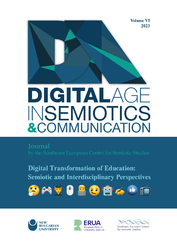Language Education, Digital Citizenship, and Juri Lotman’s Semiosphere
Language Education, Digital Citizenship, and Juri Lotman’s Semiosphere
Author(s): Despina Alexandra ConstantinidouSubject(s): Social Sciences, Language studies, Language and Literature Studies, Education, Semiotics / Semiology, Theoretical Linguistics, Higher Education
Published by: Нов български университет
Keywords: language education; digital citizenship; semiotics; semiosphere; ECML
Summary/Abstract: The present paper explores the use of language teaching for educating students into becoming digitally-literate citizens, as well as conscious, active members of the digital universe. The material discussed derives from the eLang project, a flagship project of the European Centre for Modern Languages. The guidelines, and real-world and reflexive tasks put together by the eLang team of experts, along with the theoretical framework employed are examined with respect to the notion of semiosphere by Juri M. Lotman, and the way this endorses digital transformation in language education. Seen, thus, as partaking in the digital semiosphere, and at the same time in the multiplicity of the semiotic systems ingrained in it, the current language student and future citizen assumes different roles, interacts with distinct as well as overlapping communities, is asked to make sense of multimodal resources, so as to eventually acquire far more than the skills of a digital user. The eLang material addresses, in this way, the demand for training language students in the multifarious literacies that digital literacy has come to encompass. The language student overrides, thus, classroom topography and the boundaries of conventional language education, and traces those of the globalised digital semiosphere, within which it cannot but soar.The present paper explores the use of language teaching for educating students into becoming digitally-literate citizens; as well as conscious; active members of the digital universe. The material discussed derives from the eLang project; a flagship project of the European Centre for Modern Languages. The guidelines; and real-world and reflexive tasks put together by. The eLang team of experts; along with the theoretical framework employed are examined with respect to the notion of semiosphere by Juri M. Lotman; and the way this endorses digital transformation in language education. Seen; thus; as partaking in the digital semiosphere; and at the same time in the multiplicity of the semiotic systems ingrained in it; the current language student and future citizen assumes different roles; interacts with distinct as well as overlapping communities; is asked to make sense of multimodal resources; so as to eventually acquire far more than the skills of a digital user. The eLang material addresses; in this way; the demand for training language students in the multifarious literacies that digital literacy has come to encompass. The language student overrides; thus; classroom topography and the boundaries of conventional language education; and traces those of the globalised digital semiosphere; within which it cannot but soar.
Journal: Digital Age in Semiotics & Communication
- Issue Year: VI/2023
- Issue No: 1
- Page Range: 173-184
- Page Count: 12
- Language: English

